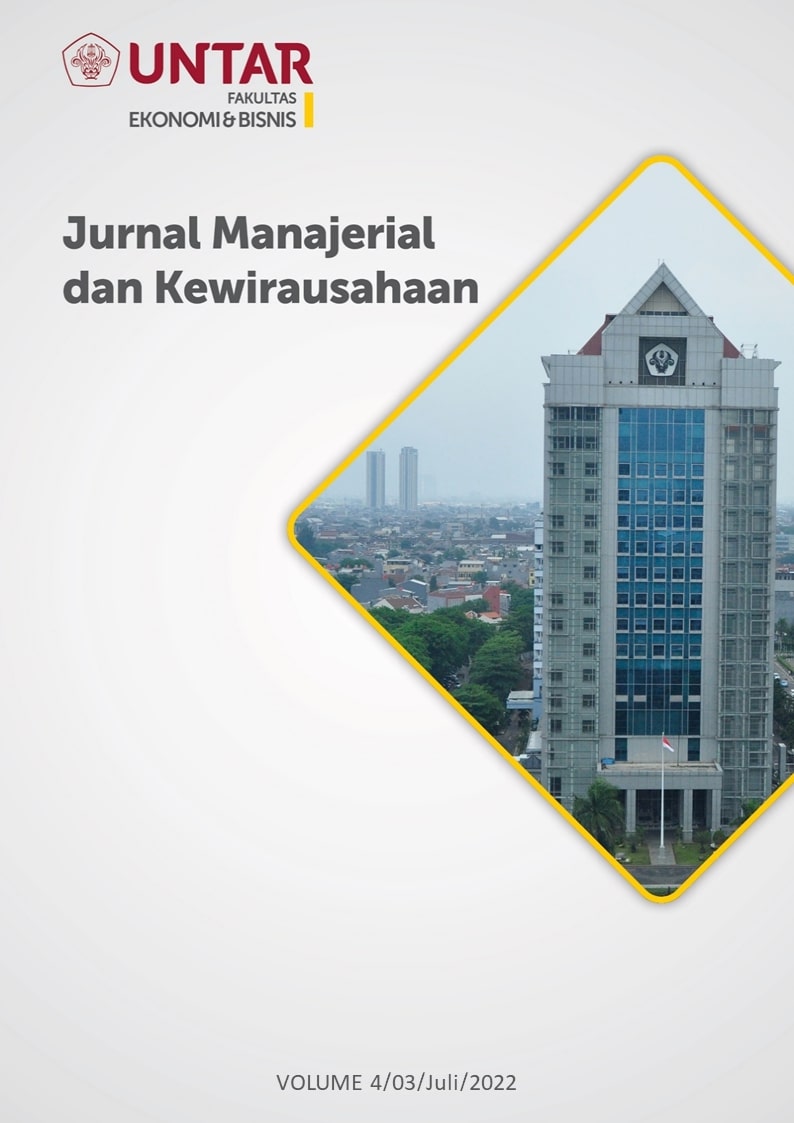Pengaruh e-WOM, Persepsi Kualitas, dan Citra Merek terhadap Intensi Pembelian Konsumen pada Produk Kosmetik Lip Tint di Jakarta
Main Article Content
Abstract
Tujuan dari penelitian ini adalah untuk menguji apakah terdapat pengaruh dari E-WOM, Persepsi Kualitas, dan Citra Merek terhadap Intensi Pembelian Konsumen pada produk kosmetik Lip Tint di Jakarta. Teknik pengambilan sampel yang digunakan dalam penelitian ini adalah non-probability sampling dengan teknik convenience sampling dimana pengambilan sampel berdasarkan ketersediaan elemen dan kemudahan untuk mendapatkannya, selain itu hanya beberapa populasi yang dapat menjadi sampel pada penelitian ini karena terdapat kriteria untuk responden. Data pada penelitian ini diperoleh dari penyebaran kuesioner dalam bentuk google form yang disebarkan kepada konsumen pengguna kosmetik lip tint di Jakarta. Alat analisis data yang digunakan adalah SmartPLS. Hasil dari penelitian ini dapat disimpulkan bahwa e-WOM terbukti berpengaruh secara positif dan signifikan terhadap intensi pembelian konsumen pada produk kosmetik lip tint. Semakin positif ulasan online dari konsumen lain pada produk kosmetik lip tint, maka tingkat intensi pembelian konsumen pada produk tersebut semakin tinggi. Lalu, persepsi kualitas terbukti berpengaruh positif dan signifikan terhadap intensi pembelian konsumen pada produk kosmetik lip tint. Semakin positif penilaian kualitas konsumen akan produk kosmetik lip tint, maka tingkat intensi pembelian konsumen pada produk tersebut semakin tinggi. Terakhir, bahwa citra merek terbukti berpengaruh positif dan signifikan terhadap intensi pembelian konsumen pada produk kosmetik lip tint. Semakin baik citra merek suatu produk kosmetik lip tint, maka semakin tinggi pula intensi pembelian pada produk tersebut.
The purpose of this study is to examine the effect of E-WOM, Perceived Quality, and Brand Image on Purchase Intentions for Lip Tint cosmetic products in Jakarta. The sample in this study was taken by using non-probability sampling with convenience sampling technique where the sampling is based on the availability of elements and the ease of obtaining them, besides that only a few populations can be sampled in this study because there are criteria for respondents. The data in this study were obtained from a questionnaire with Google Forms which were distributed to consumers who use lip tint cosmetics in Jakarta. The data analysis tool used is Smart-PLS software. The results of this study show that e-WOM is proven to have a positive and significant effect on consumer purchase intentions for lip tint cosmetic products. The more positive online reviews from other consumers on lip tint cosmetic products, the higher the level of consumer purchase intention for these products. Then, the perception of quality is proven to have a positive and significant effect on consumer purchase intentions for lip tin cosmetic products. The more positive the consumer's assessment of the quality of lip tint cosmetic products, the higher the level of consumer purchase intentions for these products. Finally, that brand image has a positive and significant effect on consumer purchase intentions for lip tint cosmetic products. The better the brand image of a lip tint cosmetic product, the higher the purchase intention for that product.
Article Details

This work is licensed under a Creative Commons Attribution-NonCommercial-ShareAlike 4.0 International License.
This work is licensed under a Jurnal Muara Ilmu Ekonomi dan Bisnis Creative Commons Attribution-ShareAlike 4.0 International License.,/p>
References
Aaker, D.A. 1991. Managing Brand Equity: Capitalizing on The Value of a Brand Name. New York The Free Press.
Buil, I., Martínez, E. and de Chernatony, L. (2013). The influence of brand equity on consumer responses. Journal of Consumer Marketing, 30(1), 62-74.
Canny & Tunjungsari, H. K. (2021). Pengujian Faktor-Faktor Yang Mempengaruhi Purchase Intention, Jurnal Muara Ilmu Ekonomi dan Bisnis, 5(2), 395-404. https://doi.org/10.24912/jmieb.v5i2.13283
Chin, T.K. and Harizan, S.H.M. (2017). Factors influencing consumers’ purchase intention of cosmetic products in Malaysia. International Journal of Business and Innovation, 3(1), 1- 15.
Erkan, I. and Evans, C. (2016). The influence of eWOM in social media on consumers’ purchase intentions: an extended approach to information adoption. Computers in Human Behavior, 61, 47-55.
Eze, U., Tan, C.-B., & Yeo, A. L.-Y. (2012). Purchasing Cosmetic Products: A Preliminary Perspective of Gen-Y. Contemporary Management Research, 8(1). https://doi.org/10.7903/cmr.10149
Hendro & Keni. (2020). eWOM dan Trust sebagai Prediktor terhadap Purchase Intention: Brand Image sebagai Variabel Mediasi. Jurnal Komunikasi, 12 (2), 298-310. https://doi.org/10.24912/jk.v12i2.7760
https://kemenperin.go.id/artikel/18957/Industri-Kosmetik-Nasional-Tumbuh-20
https://kemenperin.go.id/artikel/21460/Perubahan-Gaya-Hidup-Dorong-IndustriKosmetik
Jalilvand, M. R., & Samiei, N. (2012). The effect of electronic word of mouth on brand image and purchase intention: An empirical study in the automobile industry in Iran. Marketing Intelligence and Planning, 30(4), 460–476.
Kotler, P., & Keller, L. K. (2016). Marketing Management. In Marketing Management (15th edition). Pearson Pretice Hall.
Lee, J. E., Goh, M. L., & Bin Mohd Noor, M. N. (2019). Understanding purchase intention of university students towards skin care products. PSU Research Review, 3(3), 161-178.
Lien, C., Wen, M., Huang, L., & Wu, K. (2015). Asia pacific management review online hotel booking: The effects of brand image, price, trust and value on purchase intentions. Asia Pacific Management Review, 20(4), 210-218.
Muk, A. and Chung, C. (2014). Driving consumers to become fans of brand pages: a theoretical framework. Journal of Interactive Advertising, 14(1), 1-10.
Nuseir, M. T. (2019). The impact of electronic word of mouth (e-WOM) on the online purchase intention of consumers in the Islamic countries – a case of (UAE). Journal of Islamic Marketing, 10, 759-767.
Ordas, E.J. (2019). Lip tint Academic. Academia.edu Retrieved on July 14, 2019 http://www.academia.edu/34110661/COSMETIC.
Sekaran, U., & Bougie, R. (2013). Research Methods for Business: A Skill-Building Approach (6th ed.). Wiley.
Xiao, Z., Zhang, J., Li, D. and Samutachak, B. (2016) ‘The effect of e-WOM on country image and purchase intention: an empirical study on Korean cosmetic products in China. Int. J. Services Technology and Management, 22(1/2), 18–30.
Yan, L., Xiaojun, F., Li, J., & Dong, X. (2018). Extrinsic cues, perceived quality, and purchase intention for private labels. Asia Pacific Journal of Marketing and Logistics, 31(3), 714-727. DOI 10.1108/APJML-08-2017-0176
Zeithaml, V.A. (1988). Consumer perceptions of price, quality, and value: a meansend model and synthesis of evidence. The Journal of Marketing, 52(3), 222.



